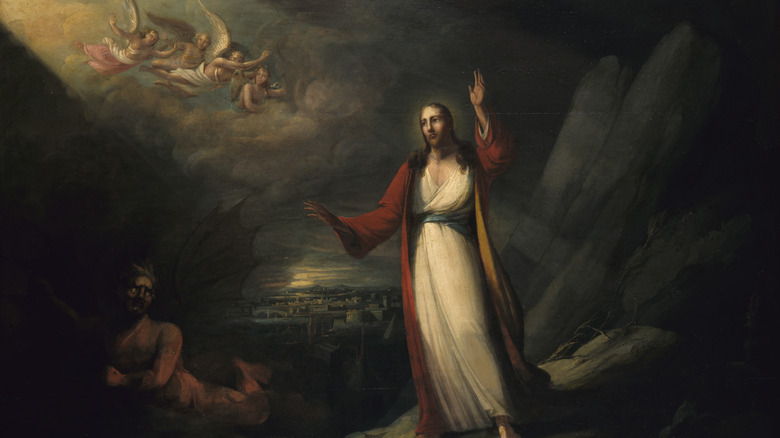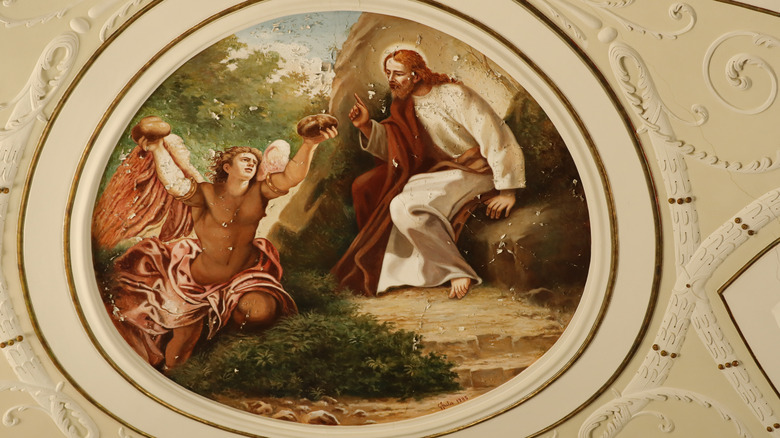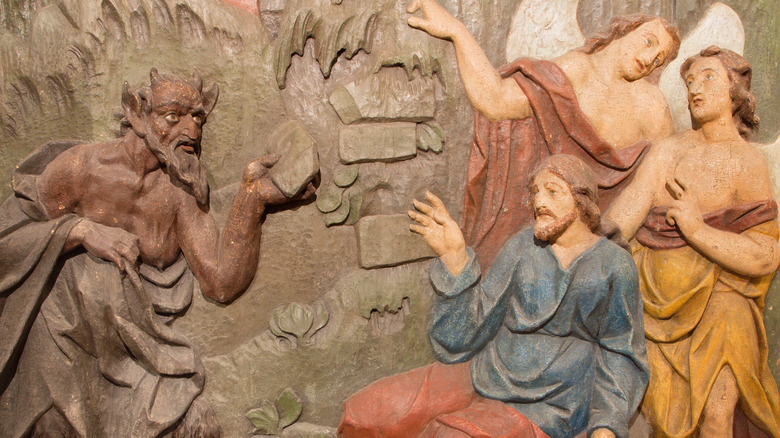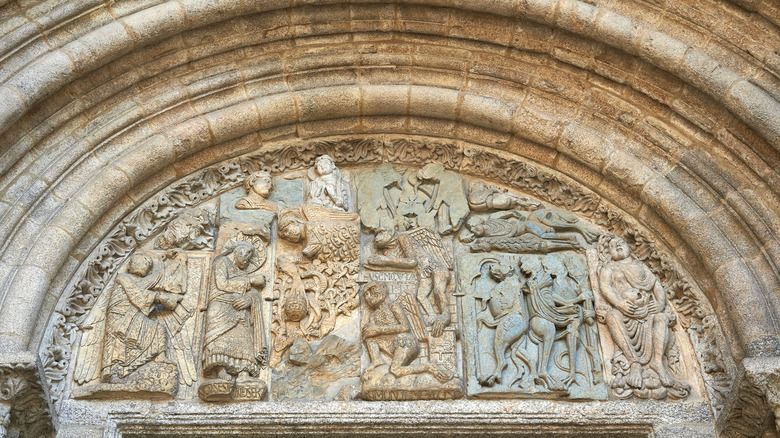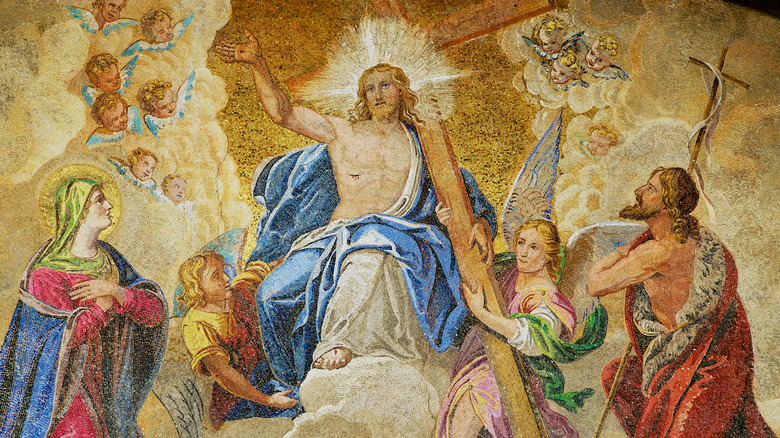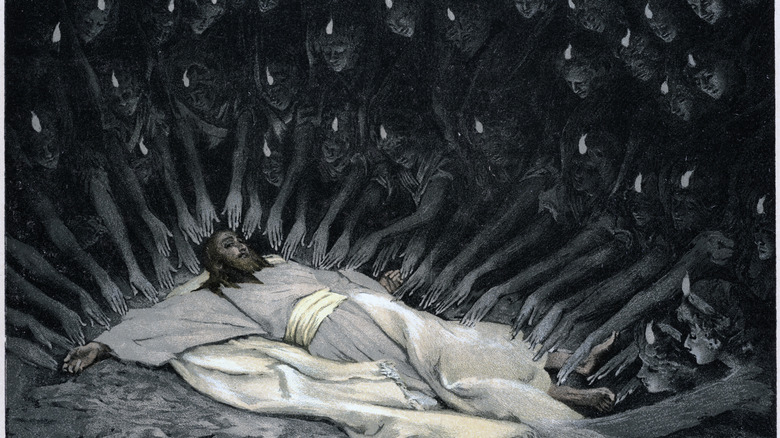The Temptation Of Christ Explained
While the temptation of Christ is perhaps lesser known than some Bible storylines — and more known as the title of a Martin Scorsese film — it contains some significant theological reflection within its borders. Jesus Christ leaves and enters the wilderness alone where he fasts for 40 days and 40 nights, which is an allusion to the wandering of the Hebrews in the Book of Exodus (via Ashland Theological Journal). At some point during his wandering and fasting, the devil comes to him and tempts him three times.
The orders of the temptations vary between Matthew and Luke, but they are all the same. First, the devil, playing off Jesus' hunger, tries to get him to turn stones into bread. When he is unsuccessful, the devil brings Jesus to the highest point of the temple and tells him to toss himself off so the angels will save him. Finally, the devil's last attempt involves taking Jesus up on a mountain and promising him all that he can see — dominion and power over all the kingdoms — if he bows down to worship the devil. Jesus does not give in to any of the temptations and alludes to elements of the Old Testament in explaining how the devil's tricks are in opposition to the will of his Father in heaven.
Versions of the story, part I
The gospels of Matthew and Luke (the first and third gospel, respectively) present the temptation of Christ as a full account of the devil's dealings with him in the wilderness. Both have three temptations, though the last two in each gospel are switched. The timeline of when the temptations took place is also slightly askew. Matthew clearly denotes that the devil came after Christ had fasted for forty days and forty nights, whereas Luke shows more of an ongoing temptation throughout his time in the wilderness. The full force of the story — or parable if preferred — is not lost in either version, however. It is the character of Christ, both fully divine and fully human, on display.
David Flusser, an Israeli professor of Early Christianity at the Hebrew University of Jerusalem, states that Matthew borrows from the gospel of Mark and the hypothetical "Q" written source (via Whole Stones). According to "Oral Tradition and Literary Dependency," this "Q" is based on the hypothesis that an earlier document existed "which the gospel authors interacted while composing their respective Gospels." Flusser goes on to say that Luke's gospel was pre-Markan (before Mark's gospel) because it does not mention the angels and wild animals in the quick two-verse mention of the temptation in Mark. This is unlike Matthew, who does mention the angels. Flusser makes the case that Matthew just forgot about the animals in his account.
Versions of the story, part II
The Gospel of Mark mentions the temptation of Christ in two verses — the evangelist simply gives us the full-on Reader's Digest version of the story. The Holy Spirit drove Christ into the wilderness, where he stayed for forty days, tempted by the devil, and was "with the wild animals and angels attended him" (via Mark 1:12-13). A significant element of Mark's version lies in the language: The Spirit "drove" Christ. In a sermon by Douglas Punke of Zion Lutheran Church in Clinton, Missouri, he relates this specific language to Gimli, the dwarf warrior in "The Lord of the Rings," in that he was not afraid of his enemy but needed Aragorn to toss him over the wall (via ZionFW.org).
The Gospel of John does not specifically relay the account of the temptation of Christ. In his book, "Studies in the Gospels," Harry Whittaker gives examples within the Gospel of John where Christ faces similar temptations. One example involves chapter 6, verse 15, where the people "sought to take him by force, and make him a king." And instead of giving in to their demands, he goes up a mountain to pray to his Father. Just like when Satan offered him the kingdoms and glory of rule, the people who flocked to him did so as well, and Jesus rebukes this temptation by leaving and communing with his Father.
Temptation #1: turn stones into bread
According to both Matthew and Luke, Christ did not eat during the forty days and forty nights in the wilderness. And of course, the devil's first temptation is to go straight for the animal desires of Christ's humanity: his gut. The devil tells him to turn a stone into bread to satiate his hunger. Knowing Jesus' divinity, the devil seeks to upend God's divine plan of redemption by having His son foil it with human desire. Christ responds to the Devil with a callback to Deuteronomy 8:3: "Man shall not live by bread alone."
The remainder of that saying is: "But man lives by every word that proceeds from the mouth of the Lord." Jesus understands that the devil knows the prior declarations of his Father since he witnessed all of the events of the Old Testament and took part in similar temptations — Adam and Eve, Job, etc. Jesus does not need to finish the statement, for it is known to the devil.
Temptation #1: interpretations
The BBC puts the typical interpretation of this temptation succinctly: "This shows that he is not concerned with material things but with spiritual food given by God." They go on to notate that the temptation brings to Jesus the question of how he is to use his divine power: for his own satiation, or for the good of others? This would also be a recognition by Christ that his divinity was meant for the redemption of all humanity as opposed to his own temporary desires. Allen Ross, professor of Old Testament and Hebrew at Beeson Divinity School, writes for Bible.org: "The temptation was to turn His spiritual nature into a means of satisfying His material need without reference to finding the will of God. In fact, he would be doing the will of the devil. The devil simply chose a little thing for the test; but it would have destroyed the work of Christ."
If someone feels a form of deprivation in their life, the point of this temptation is not to control the situation by one's will, but to recognize the bigger picture of what God is doing in that space of deprivation. Just like the Hebrews in the Deuteronomy passage that Christ quotes to the devil, God gave them manna (bread) but did so with specific instructions. Indeed, these guidelines would teach them that following the "words of God" would lead to their physical desires being met, and perhaps more importantly, feed their spiritual natures in the process (via Bible.org).
Temptation #2: pinnacle of the temple
The devil takes Christ to the "pinnacle of the temple" and quotes Psalm 91:11-12 to Jesus about how God will command the angels to lift him up so he will not strike his foot on the ground. The devil ups his tempting game by using the Old Testament to test Christ. Using scripture against him, the devil tells Christ to leap from the pinnacle "if you are the Son of God" (via Matthew 4:6). Ross Allen speaks to the conditionality of this statement by the devil on Bible.org: "When [the Devil] said, 'If you are the Son of God,' he did not mean 'If you are the Son of God [but you are not],' but rather he meant 'since you are the Son of God.' He knew who this was, and would build his temptation on it."
Jesus responds with another scripture verse from Deuteronomy, this time from chapter 6, verse 16: "Do not put the Lord your God to the test." This phrase comes right after Moses delivers the Ten Commandments to the Hebrew people in the wilderness and ties all of the commandments and teachings to loving God, which is what the Law of God pointed towards. Jesus is declaring to the devil that he should not put his Lord to the test, notating that God created Satan before he rebelled against his creator. In addition, Christ is noting that the devil knows what he is doing here by tempting him.
Temptation #2: interpretations
BBC once again provides a succinct interpretation of this temptation. However, their understanding of the devil's knowledge of Jesus' true identity conflicts with Ross Allen's: "Again, the challenge to Jesus was to misuse his power," the outlet writes. "But it also asked Jesus to prove that he was the Messiah and that God really cared for him. This question was an important one for Jesus to deal with because he would be faced with it again and again as people questioned his identity and authority." It is clear that the devil is seeking to subvert Jesus' divine mission by using his own power against him. He is tempting Christ to save himself instead of saving others — a test he would face over and over, especially on the cross.
But Andrei A. Orlov of Marquette University offers another interesting understanding of this temptation through the lens of Jewish tradition and Catholic acceptance of the biblical Apocrypha, which are the works excluded from the Jewish and Protestant Old Testaments. He notes that the gospel writers were probably familiar with Enochic descent traditions where angels would abandon their place in the heavenly temple (rebel) and descend down to Earth and corrupt humanity. In asking Jesus to descend down from the pinnacle of the temple, the devil is asking Jesus to abandon his heavenly ministry and descend to enact his own human will. Ultimately, the devil is asking Jesus to follow him instead of God in a literal descent from divinity.
Temptation #3: on the mountaintop
In the final temptation of Christ in Matthew (and second temptation in Luke), the devil takes Christ up to a high mountain to show him "all the kingdoms of the world and their splendor. The devil then tells him that Christ can have it all if he bows down and worships him. He is offering up the dominion of the worldly kingdoms and all of the power that reign would entail if Christ gives allegiance to his Father's fallen creation. As we have noted before, the devil is wise to who Christ is and what his purpose is meant to be. The International Bible Encyclopedia states: "The lure here is the desire for power, in itself a right instinct, and the natural and proper wish to avoid difficulty and pain." Ultimately, the devil is toying with Jesus by offering him the end goal of his divine mission without the pain and suffering of the cross.
Jesus once again responds to the devil with a quote from Deuteronomy 6:13-15: "Fear the Lord your God, serve him only and take your oaths in his name. Do not follow other gods ... his anger will burn against you, and he will destroy you from the face of the land." Here we see Jesus understands the fear of the Lord is not fear in the sense we normally understand it, but as reverence and worship. If Jesus had worshipped the devil, he would have caused the ire of his own Father.
Temptation #3: interpretations
BBC states again that this temptation "tested Jesus' devotion to God and also his desire for political power. However, Jesus showed that his idea of a Messiah was not one who had political power but one who put God's kingdom first." This temptation would rear its head through the Bible as the people who flocked to Jesus — including his apostles — saw him as an earthly messiah instead of a messiah who would bring down heaven to Earth (via Education Bureau to Hong Kong). In a piece for Bible.org, Allen Ross points out the irony of the reward the devil offered Christ: "Second, all Satan could offer were the 'kingdoms,' plural kingdoms–these warring, divided, conflicting powers and races in the world. Who wants them? The Father had promised the Son a kingdom, united in peace and righteousness and harmony" (via Bible.org). God's purpose had a higher goal in mind, and that mission could only be achieved through Christ's obedience to his Father unto the cross — the traditional moment when all of humanity and creation was redeemed.
Postlude: Jesus being ministered by angels
Both Matthew and Mark speak to the moment when the devil leaves Christ after unsuccessfully tempting him, and the angels attend (or minister) to him. Mark notes an extra accompaniment of the wild animals or beasts along with the angels. Thomas Manton, a Puritan, put this scene into a 1,000 foot-view in one of his sermons. "When we read the story of his temptations, how he was tempted in all parts like us, we might seem to take scandal, as if he were a mere man therefore his humiliation is counterbalanced with the special honor done to him: he was tempted as man, but, as God, ministered unto by angels" (via A Puritan's Mind).
Christ empathized with humanity to the very level of deprivation and temptation, but he was pure enough to reject those temptations. Yet, as Manton notes, he was also fully God and the angels were there to minister and attend to him as the true Son of God who maintained obedience to his Father. In some ways, one could maintain that the wild animals, too, understood this victory and celebrated it with the angels. However, we are not given enough information to say this conclusively.
Postlude: interpretations
Church Father John Chrysostom gave us a practical interpretation of this postlude when he stated: "That you also may learn, that after your victories which are copied from His, angels will receive you also, applauding you, and waiting as guards on you in all things" (via New Advent). In other words, those who are faithful to God and suffer deprivations and temptations as Christ did in the wilderness will, too, be attended to and guarded by the angels amid their victories against dark nights of the soul. Because Christ was faithful to his Father to the end, God does command the angels to lift him up and minister to him like Psalm 91 stated (and the devil misused).
The Protestant pastor, Charles Spurgeon, states in his sermon, "[God] has appointed angels to watch over His own people, and inasmuch as Jesus is our brother, as the children were partakers of the ministry of angels, he himself also took part with the same that he might show how he took our weakness upon him, and therefore needed and received that succor which the Father has promised to all His children" (via Spurgeon Gems). To Christ, the ministry of the angels is a recognition that in his humanity, he was exhausted as we would be and needed the help of the angelic touch. In all of this, we are shown that Jesus is faithful to his Father and deeply empathetic to his and our humanity.
Cultural representations, part I
Perhaps the most known cultural representation of Christ's temptations is in Martin Scorsese's 1988 film, "The Last Temptation of Christ," featuring Willem Dafoe as the titular character. The film itself drew the ire of both Catholics and Protestants, who saw it as a defilement of the person and divinity of Jesus. In particular, in a death dream on the cross, the movie shows Jesus consummating his love for Mary Magdalene. As reported by PBS, the backlash was fierce: "Some 1,200 Christian radio stations in California denounce the film, and Mastermedia International urges a boycott against parent company MCA. Bill Bright offers to reimburse Universal for its investment in 'The Last Temptation of Christ' in exchange for all existing prints, which he vows to destroy." The film remains banned in Singapore and the Philippines, per IMDb.
Another film of note is Pier Paolo Passolini's "The Gospel According to St. Matthew," which is a portrayal of exactly what the title notates. Notably, Passolini largely utilized the text of the gospel in his script, which was surprising to those who knew of his novels and films. Passolini would go on to direct numerous movies — like "Salò, or the 120 Days of Sodom" and the short film "La Ricotta" — in which Jesus also makes appearances. Both of these films received criticism for blasphemy (mainly for "La Ricotta") and pornography (in the case of "Salò"). Still, critics and Christians were deeply taken by "The Gospel According to St. Matthew" — the opposite of the reaction to Scorsese's "The Last Temptation of Christ."
Cultural representations, part II
In the literary world, the temptations of Jesus find representation as well. In his book, "The Razor's Edge," W. Somerset Maugham has a character recite nearly the whole story of the temptations of Christ. Yet to serve a wider purpose for the novel and to point towards Christ's ultimate sacrifice, Maugham ends the story like this: "That's the end of the story according to the good simple Matthew. But it wasn't. The devil was sly and he came to Jesus once more and said: If thou wilt accept shame and disgrace, scourging, a crown of thorns and death on the cross thou shalt save the human race, for greater love hath no man than this, that a man lay down his life for his friends. Jesus fell. The devil laughed till his sides ached, for he knew the evil men would commit in the name of their redeemer" (via Project Gutenberg Canada). This is almost an inversion of the actual gospel story of the cross. According to the Scriptures, the cross showed the victory over the devil, yet here Maugham points to how humanity continues to take this sacrifice for granted and do horrible things in the name of Christ.
Elsewhere, John Milton wrote a lengthy poem detailing the temptations of Christ as a rejoinder to his epic "Paradise Lost" called "Paradise Regained," which retells the temptation according to the gospel of Luke in blank verse, per eNotes.
